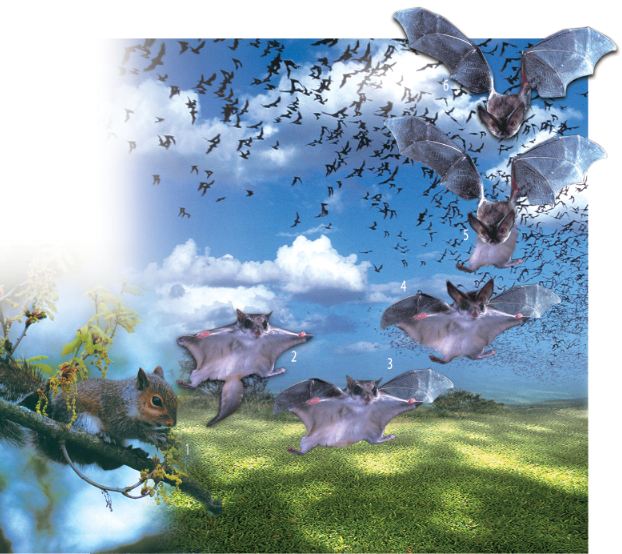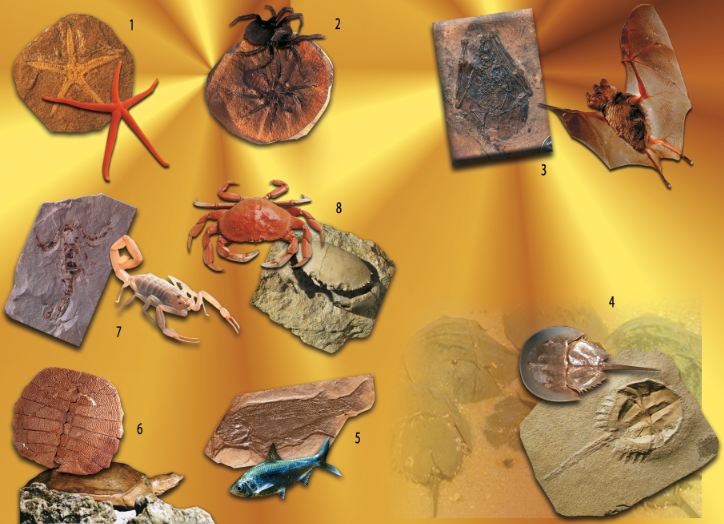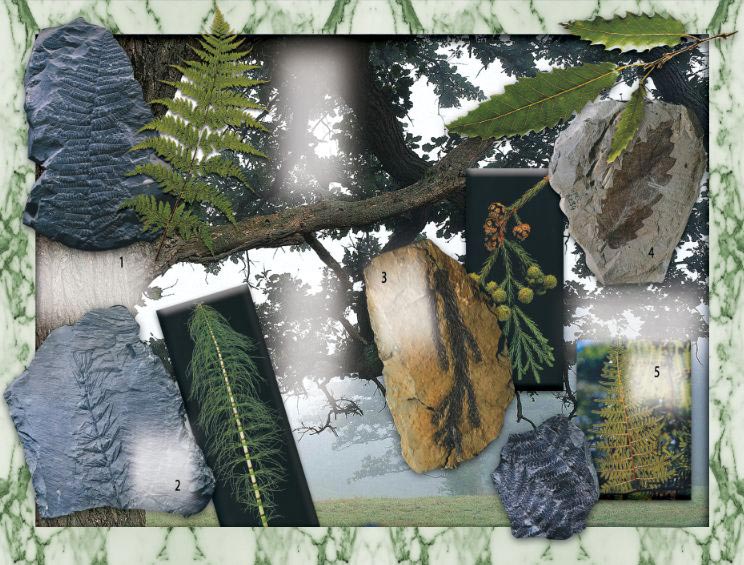One of the clearest features of the fossil record is that living things have undergone no observed changes during the geological periods. However a living species first appears in the fossil record, so it maintains exactly the same structure until it disappears—or over tens of millions, or even hundreds of millions of years until it reaches the present day, experiencing no changes in the meantime. This is clear proof that living things never undergo any evolution.

A 25-millionyear-old termite fossil
One of the first people to announce this truth is the American paleontologist and natural historian, Stephen Jay Gould, one of the 20th century’s best-known evolutionist authorities. In 1970 Gould wrote the following about two most distinguishing features of the fossil record:
The history of most fossil species include two features particularly inconsistent with gradualism:
1) Stasis — most species exhibit no directional change during their tenure on earth. They appear in the fossil record looking much the same as when they disappear; morphological change is usually limited and directionless;
2) Sudden appearance — in any local area, a species does not arise gradually by the steady transformation of its ancestors; it appears all at once and “fully formed.”196
In the years that followed, Gould admitted that he accepted the stasis observed in the fossil record. In a paper in Natural History magazine in 1993, he wrote:
The stasis, or nonchange, of most fossil species during their lengthy geological lifespans was tacitly acknowledged by all paleontologists, but almost never studied explicitly because prevailing theory treated stasis as uninteresting nonevidence for nonevolution. Evolution was defined as gradual transformation in extended fossil sequences, and the overwhelming prevalence of stasis became an embarrassing feature of the fossil record, best left ignored as a manifestation of nothing (that is, nonevolution).197
 |
| A complate present-day souirrel (picture 1) |
In their book The Myths of Evolution, Ian Tattersall and Miles Eldredge, both well-known paleontologists, described how the stasis in the fossil record conflicted with the assumptions of Darwinism:
Paleontologists just were not seeing the expected changes in their fossils as they pursued them up through the rock record . . . That individual kinds of fossils remain recognizably the same throughout the length of their occurrence in the fossil record had been known to paleontologists long before Darwin published his Origin. Darwin himself, . . . prophesied that future generations of paleontologists would fill in these gaps by diligent search . . . One hundred and twenty years of paleontological research later, it has become abundantly clear that the fossil record will not confirm this part of Darwin’s predictions. Nor is the problem a miserably poor record. The fossil record simply shows that this prediction is wrong.
The observation that species are amazingly conservative and static entities throughout long periods of time has all the qualities of the emperor’s new clothes; everyone knew it but preferred to ignore it. Paleontologists, faced with a recalcitrant record obstinately refusing to yield Darwin’s predicted pattern, simply looked the other way.198
There are countless examples of this stability. For instance, the Bighorn Basin in Wyoming contains 5-million-year-old fossil beds going back to the first periods of mammals. The fossil record here is so rich that paleontologists expected to find transitional forms in the fossils there that would demonstrate the evolutionary process. Yet their hopes were all in vain. It was realized that the species they suggested had evolved from one another in fact all appeared in the same periods. It was seen that “The known fossil record is not, and never has been, in accord with gradualism.”199
Frthermore, species remained stable, with no changes, over the millions of years until they disappeared from the record.
 |
| picture1: Above, a roughly 135-million-yearold Echinoderm (starfish) fossil, and a living specimen. |
According to the claims of the theory of evolution, however, in order for species to be able to evolve from one another, they need to be in a constant state of change. For example, in order for a rodent to turn into a bat or a whale, it must exhibit minute, gradual changes over very long periods of time. In order for a rodent to acquire new characteristics, these gradual changes have to take place over an exceedingly long time frame. Over this period of time, there should be many transitional forms that should leave millions of fossils behind them. Yet there is no trace of living things with transitional form features in the fossil record. The fossil rodents discovered are all creatures with full and distinguishing features, just like bats and whales, and are found fully formed.
Niles Eldredge and Ian Tattersall admit the absence of transitional forms in the fossil record—and although it is well known to evolutionist paleontologists, but that they just ignore it:
Darwin himself . . . prophesied that future generations of paleontologists would fill in these gaps by diligent search. . . . One hundred and twenty years of paleontological research later, it has become abundantly clear that the fossil record will not confirm this part of Darwin’s predictions. Nor is the problem a miserably poor record. The fossil record simply shows that this prediction is wrong. 200

The Bighorn Basin in Wyoming
The fossil record can be seen to refute the theory of evolution in every regard. A separate, noteworthy point that Eldredge makes is how studies that show that species do not change in the fossil record, but rather remain entirely stable, are not published and are described as “unsuccessful.” Evolutionists are highly experienced at hiding away evidences against the theory of evolution, not just with regard to fossils but in other relevant branches of science, and at misleading society with biased interpretations. This method, a familiar one among evolutionists, can be seen between the lines of Eldredge’s words.
Despite being an evolutionist publication, Focus magazine in its April 2003 edition, which dealt with the coelacanth, referred to species like that fish, which have remained unchanged over millions of years:
The discovery that a creature as large as the Cœlacanth had lived for so many years outside the knowledge of the scientific world led to its attracting a great deal of interest. Yet there are a very large number of organisms which, like the Cœlacanth, are identical to fossils remaining from millions of years ago. For example, the Neopilina, a species of crustacean, has remained unchanged for 500 million years, the scorpion for 430 million years, the Limulus, a marine creature with armour and a sword-like tail, for 225 million years, and the Tuatara, a species of reptile living in New Zealand, for 230 million years. Many arthropods, crocodiles, turtles and many species of plant are other components of this growing list.201
Focus openly admits the blow dealt by these fossils to the theory of evolution:
Looked at from the evolutionary perspective, the probability of organisms such as these undergoing mutation is much higher than that of others. Because every new generation means the copying of DNA. Bearing in mind the number of times the copying process takes place over millions of years, a very interesting picture emerges. In theory, various elements of pressure such as changing environmental conditions, hostile species and competition between species should lead to natural selection, the selection of species advantaged by mutation, and for these species to undergo greater change over such a long period of time. YET THE FACTS ARE OTHERWISE. Let us consider cockroaches, for example. These reproduce very quickly and have short life spans, yet they have remained the same for approximately 250 million years. Archaeobacteria are an even more striking example. These emerged 3.5 billion years ago, when the Earth was still very hot, and are still alive today in the boiling waters in Yellowstone National Park.202
The fact that living fossils such as the coelacanth have remained unchanged between the day they first appeared and the present is compatible not with evolution—which mandates constant change—but with the fact of creation, which reveals that species are individually created and have come down unchanged to our own time. Living fossils are all proofs of creation. God has created all the millions of living species in a miraculous manner.
 |
| Fossilized plants millions of year old and examples of these fossils living today are proof that these plants never underwent any evolution. These species have remained unchanged for millions of years. |
196 Stephen J. Gould, “Evolution’’ Erratic Pace,” Natural History, Vol. 86, No. 5, May 1977, p. 14. ![]()
197 Stephen J. Gould, “Cordelia’s Dilemma,” Natural History, February, 1993, pp. 10-18. ![]()
198 Niles Eldredge and Ian Tattersall, The Myths of Human Evolution, New York: Columbia University Press, 1982, pp. 45-46. ![]()
199 Steven M. Stanley, The New Evolutionary Timetable, New York: Basic Books, 1981, p. 71. ![]()